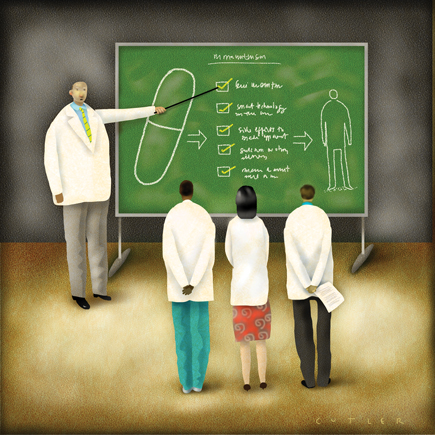Complexity of ‘migraineurs' challenges diagnosis, treatment
Migraines are a seemingly simple complaint for patients, but a diagnostic challenge for internists, who have to sort through the symptoms and potential causes. Sometimes, the treatment regimens are just as complex as the condition itself.
On any given day, chances are an internist will see at least one patient who complains of headache. Each year, more than 95% of women and 90% of men will suffer from headache pain, and of those who do, 18% of women and 15% of men will consult a physician about their symptoms.
They often come to their appointments fearing the worst: a brain tumor. Although that is rarely the case, internists must sort through myriad symptoms to arrive at a diagnosis and appropriate treatment. Most often—in 9 out of 10 patients seeking medical treatment for headache pain, according to one study—the culprit is migraine, a complex condition that poses challenges for internists.
“Many internists and patients don't really understand what a broad concept migraine is. It's not just a headache, but a syndrome of which headache is a part. Migraine is also nausea, aura, motion sickness, menstrual headaches, and so on,” said Martin A. Samuels, MD, MACP, chairman of the department of neurology at Brigham and Women's Hospital and professor at Harvard Medical School in Boston.
However, symptoms of migraine often overlap with those of other conditions, which is why thorough questioning and a neurological examination are crucial to an accurate diagnosis, said George Sarka, MD, MPH, FACP, associate clinical professor of medicine at the University of California–Los Angeles.
The most important questions to ask cover severity and duration, he added. “How long has the patient had the pain? Is it recent? Has it changed or gotten worse in severity or frequency? If it's new and it's extreme, then you have to worry.” Sudden onset of excruciating headache could be a sign of subarachnoid hemorrhage, vasculitis, or cranial sinus thrombosis, and a trip to the emergency department for a workup would be in order, he said.
As most patients who see internists for headache pain will not be in the throes of a neurological emergency, the next step is to determine whether the headache is primary or secondary to another condition. Primary headaches include migraine, tension, and cluster headaches, and treatment will depend on frequency and duration of pain as well as what the patient can tolerate, said Stephen Silberstein, MD, FACP, director of the Jefferson Headache Center at Thomas Jefferson University in Philadelphia.
He added that lifestyle interventions should also be considered. “Smoking, being overweight, and not getting enough sleep are all known to cause problems with headache, so any long-term regimen will address those things and include regular exercise.”
In terms of drug treatment, the therapeutic “ladder” for chronic headaches has three steps: abortive therapy, including over-the-counter (OTC) medications such as non-steroidal anti-inflammatory drugs (NSAIDs) and acetaminophen, prescription abortive therapy, and prophylactic therapy.
Challenge of OTCs
Starting with OTC treatments may seem like a no-brainer, but suggesting that a patient simply take ibuprofen or acetaminophen may be counterproductive, said Richard Lipton, MD, professor of neurology at Albert Einstein College of Medicine and director of the Montefiore Headache Center in New York.
“Generally speaking, by the time people see a doctor, they've already tried that,” he said. “Their headaches are coming more frequently and are making the transition from being a nuisance to interfering with the patient's ability to function.”
And OTC medications present their own challenges. Taking them for long periods of time may result in rebound headaches, especially in patients predisposed to migraine or chronic daily headaches. The National Headache Foundation's Clinical Update on Caffeine and Headache notes that the most commonly overused OTC medications are single-agent NSAIDs, followed by acetaminophen. Although “caffeine withdrawal” may cause an acute episode of headache, the update notes that patient overuse of caffeine for treating headache is relatively rare.
Rebound headaches aside, experts agree that long-term use of NSAIDs should be avoided because of the potential for gastrointestinal complications such as bleeding and ulcers. Likewise, long-term use of acetaminophen should be avoided because of the potential for liver damage and toxicity.
Given that most patients have already tried OTC medications by the time they schedule an appointment with their physicians, Douglas C. McCrory, MD, MHSc, associate professor of medicine at Duke University Medical Center in Durham, N.C., has no qualms about moving right to prescription treatment, particularly for migraineurs.
“One school of thought is to start at the bottom and move up,” he said. “But if assessment reveals that someone's headache is severe enough to warrant a prescription, why not?”
Stronger therapy
The next rung on the treatment ladder is prescription abortive therapy to be taken orally, nasally, or by injection at the onset of headache or shortly thereafter. For migraine, these medications include the triptans, dihydroergotamine (either by injection or nasal spray), and ergotamine tartrate with caffeine. However, triptans may cause rebound headaches in some patients, and patients should be instructed in proper use.
There is a threshold for abortive therapy, however. “A good rule of thumb for acute treatments is that they should not be taken more than two or three days a week, or eight or nine days a month,” said Dr. Lipton.
When relief requires more than that, it's time to consider prescription prophylactic therapy. In the April 24 issue of Neurology, the American Academy of Neurology (AAN) updated its guidelines for migraine prevention and noted that the following medications have been “established as effective” in preventing migraines in adults: divalproex sodium, sodium valproate, topiramate, metoprolol, propranolol, timolol, and, for short-term prophylaxis, frovatriptan. The Academy noted that the following medications are “probably effective” in preventing migraines, as well: amitriptyline, venlafaxine, atenolol, nadolol, and for short-term prophylaxis, naratriptan and zolmitriptan.
According to Peter J. Goadsby, MD, PhD, DSc, professor in the department of neurology and director of the University of California–San Francisco Headache Center, internists should also consider any other conditions a patient may have. “Very often you can come to a decision based on all the things you know about the person,” he said. “Some medications would be ruled out right away. For example, you wouldn't give propranolol to a patient with asthma.”
Yet some conditions lend themselves to therapeutic optimization, he added. “Consider any comorbid illness that might promote the use of a particular medication. If the patient has hypertension, a beta-blocker might be a good choice. If the patient is overweight, topiramate might work because it will not cause weight gain.”
Dr. Sarka stressed the importance of listening to the patient, as what the patient says may provide clues about aspects of his or her lifestyle that would be affected by certain therapies. “Tricyclics would help those who aren't sleeping well. The side effects of beta-blockers, like slowed pulse, would not appeal to patients who exercise to get their heart rate up,” he said.
In 2010, the Food and Drug Administration (FDA) approved injections with botulinum toxin A (Botox) for patients who suffer chronic migraines lasting for at least four hours, at least 15 days each month. The Phase III Research Evaluating Migraine Prophylaxis Therapy (PREEMPT) trials on which approval was based did not indicate that the treatment works for episodic migraine, however. Internists wishing to offer the treatment should be trained in the PREEMPT protocol, said Dr. Lipton. “My feeling is that it should be given the way it was given in the trials,” he noted.
Herbs and supplements
Some patients may take, or inquire about taking, herbal therapies or nutritional supplements to treat their headaches. There is evidence to support the use of several of these treatments, but not for others.
A 2004 study by Dr. Lipton and colleagues suggested that 75 mg of butterbur twice a day can reduce migraine attacks by 48%. “The caveat is that incorrect extraction results in toxic alkaloids, so I can only speak for the German brand we used in the study,” he said. The updated AAN guidelines list butterbur as “established as effective” for migraine prevention.
Some studies suggest that feverfew prevents or stops migraine headaches, and the updated AAN guidelines list a feverfew extract known as MIG-99 as “probably effective” for preventing migraines. The University of Maryland's Complementary and Alternative Medicine Guide notes a recommended dose of 100 to 300 mg, up to four times daily, standardized to contain 0.2% to 0.4% parthenolides, or 6.25 mg three times daily for supplements that are carbon dioxide extracted.
Evidence is similarly strong for supplementation with riboflavin (vitamin B2), but more for prevention than treatment of migraine. The suggested dosage is 400 mg/d, according to the University of Maryland guide.
There is weak evidence to support supplementation with coenzyme Q10 for the prevention or alleviation of headache in children and adolescents. One study published in the January 2007 Headache suggested improvement with supplementation, but another study in the June 2011 Cephalalgia showed no difference between supplementation and placebo.
Herbs and supplements should be approached with caution because they are not evaluated or controlled by the FDA, said Dr. Samuels. “You don't really know what's in the bottle, and I've seen some serious complications from herbs that contained substances patients didn't know about,” he noted.
Patient education will go a long way toward successful treatment, regardless of the therapies employed, said Dr. McCrory, who encouraged internists to reassure patients of their options.
“Help them understand that headache management is more than just taking one prescription,” he said. “It's a plan that includes multiple drugs as well as non-drug therapy. Educating patients allows them to be more creative and empowered in managing their headaches.”




